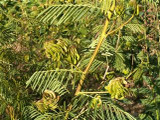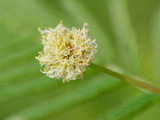






Illinois Bundleflower
Description
Illinois Bundleflower is a 2 to 4-foot-tall Native leguminous plant with a ferny appearance. It occurs naturally in black soil prairies, meadows near rivers, moist open woodlands, and similar areas.
The stems are light green, and the leaves are yellowish green with white hairs along the stems around the margins of the leaves. It has small white compound flowers near the top of the upper leaves, with each flower consisting of many narrow tubular florets pointing in all directions. Several yellow stamens protrude from each floret, which, when fully developed, give the flower a starburst-like appearance, although the flowers are not very showy by themselves. It blooms during early or mid-summer.
Illinois Bundleflower prefers full or partial sun and somewhat moist conditions, with best growth in fertile loam soils and less tolerance to coarse sands and dense clays. Because it is a legume, it fixes high amounts of nitrogen, making it excellent for repairing worn-out soil. It is also highly palatable to herbivores, with a high protein content in both leaves and seeds.
Illinois Bundleflower can be used in rangeland, wildlife habitat improvement, and in roadsides, parks, and recreation areas for stabilization and beautification. It can be seeded in early spring or late fall and may take two full growing seasons to fully establish, with weed control important during the establishment period. After establishment, plants disperse by re-seeding, so leave the seed pods on the plant after flowering for this purpose.
Growing Height: 2-4"
Seeds Per Pound: 85000
Acre Rate: 10 lbs
Lbs per 1000 sq feet: 4 oz.
Growing Region: Southwest (not including Arizona), Northwest, Southwest (not including West Virginia), Pennsylvania, Maryland
Zone
Planting Information
Plant Characteristics







